
MV Agusta is a motorcycle manufacturer founded by Count Domenico Agusta on 19 January 1945 as one of the branches of the Agusta aircraft company near Milan in Cascina Costa, Italy. The abbreviation MV stands for Meccanica (mechanics) Verghera, the hamlet where the first MVs were made. The modern headquarters and main production facilities are located in Varese, Italy on the shore of Lake Varese.
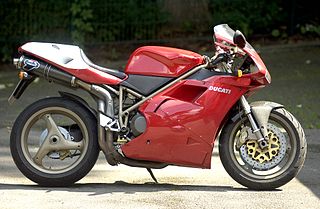
The Ducati 916 is a fully faired sport bike made by Ducati from 1994 to 1998. Featuring a 916 cc (56 cu in) fuel injected, 4-valve, desmo, liquid-cooled, 90° V-twin engine in a trellis frame with a single-sided swingarm and USD forks, the 916 is frequently cited as one of the most beautiful motorcycles ever.

Bimota is a small Italian manufacturer of custom and production motorcycles. It was founded in 1973 in Rimini, Italy by Valerio Bianchi, Giuseppe Morri, and Massimo Tamburini. The company name is a portmanteau derived from the first two letters of each of the three founders' surnames, Bianchi Morri Tamburini.
Cagiva is an Italian motorcycle manufacturer. It was founded in 1950 by Giovanni Castiglioni in Varese, originally producing small metal components. Giovanni's sons, Claudio and Gianfranco Castiglioni went into the motorcycle industry in 1978. The name is a portmanteau derived from the founder's name 'Giovanni Castiglioni' and the founding location, i.e. CAstiglioni GIovanni VArese.
Massimo Tamburini was an Italian motorcycle designer for Cagiva, Ducati, and MV Agusta, and one of the founders of Bimota. Tamburini's designs are iconic in their field, with one critic calling him the "Michelangelo of motorbike design". His Ducati 916 and MV Agusta F4 were included in the Guggenheim Museum's The Art of the Motorcycle exhibit of 1998–1999.

Randy Mamola is an American former professional Grand Prix motorcycle road racer and current television sports commentator. He was one of the most charismatic Grand Prix motorcycle racers of his generation, becoming a favorite because of his interaction with race fans both on and off the track, as well as his aggressive, spirited riding style.

The Ducati Paso was introduced in 1986 with the slogan "Il nostro passato ha un grande futuro". The name was in honour of racer Renzo Pasolini, nicknamed "Paso", who died on 20 May 1973 in an accident at the Monza race track during the Italian motorcycle Grand Prix.

Ron Haslam is an English former Grand Prix motorcycle road racer who had been racing for over thirty years, winning three World titles, four British championships and having ridden in almost 110 GPs. Haslam spends much of his time helping his son Leon Haslam in his racing career and training riders and racers alike at his Race School based at Donington racetrack, Leicestershire.

Renzo Pasolini, nicknamed "Paso", was an Italian professional Grand Prix motorcycle road racer in the 1960s and early 1970s.
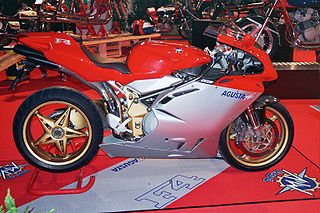
The MV Agusta F4 is a four-cylinder sport bike made by MV Agusta from 1999 until 2018. It was the motorcycle that launched the resurrection of the brand in 1998. The F4 was created by motorcycle designer Massimo Tamburini at CRC, following his work on the Ducati 916. The F4 has a single-sided swingarm, large diameter front forks and traditional MV Agusta red and silver livery. The F4 engine is also one of the few production superbikes to have a hemi-spherical cylinder head chamber design with 4 valves per cylinder.
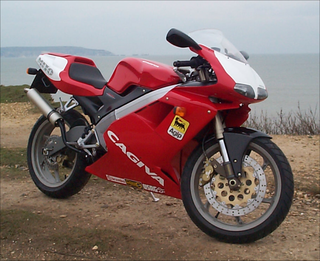
The Cagiva Mito is a small-engined Cagiva sports motorcycle. The powerplant consists of a two-stroke 125 cubic centimetres (7.6 cu in) single-cylinder engine.
The 1988 Grand Prix motorcycle racing season was the 40th F.I.M. Road Racing World Championship season.

The 1992 Grand Prix motorcycle racing season was the 44th F.I.M. Road Racing World Championship season. Honda secured the constructor's title in all three categories.
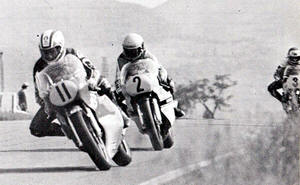
Marco Lucchinelli is an Italian former professional Grand Prix motorcycle road racer. In 1981 he won the FIM 500cc World Championship. He is a MotoGP Legend.

The 1990 Yugoslavian motorcycle Grand Prix was the seventh round of the 1990 Grand Prix motorcycle racing season. It took place on the weekend of 15–17 June 1990 at the Rijeka circuit.
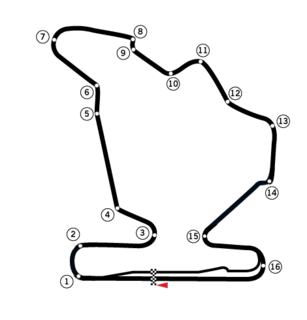
The 1992 Hungarian motorcycle Grand Prix was the ninth round of the 1992 Grand Prix motorcycle racing season. It took place on the weekend of 10–12 July 1992 at the Hungaroring circuit.
Grand Prix motorcycle racing sponsorship liveries have been used since the late 1960s, replacing the previously used national colours. With sponsors becoming more important with the rising costs in the motorcycle CC classes, many teams wanted to be able to display the logos of their sponsors as clearly as possible.
The Paton PG500R and Paton PG500RC are racing bikes of the Italian motorcycle manufacturer Paton, which debuted in the 500cc class of grand Prix motorcycle racing from 2000 until 2001, only participating in a few races, due to a lack of funds from the company and the difficulty of finding a sponsor.
Nicola Materazzi is an Italian mechanical engineer who developed several sports and racing cars, including the Ferrari 288 GTO, Ferrari F40 and Bugatti EB110. He is best known for being Italy's turbo specialist from the mid 1970s as well as a respected sports car and motorcycle engineer.

The Cagiva C593 was a racing motorcycle made by Cagiva, which was used in the 500cc class of Grand Prix motorcycle racing during the 1993 season. The name is formed by an amalgamation of words and letters, namely the "C", "5" and "93". The "C" stands for the company (Cagiva), the "5" stands for the class the company races in as well as the engine capacity (500) and the "93" stands for the season the bike raced in (1993). The bike replaced the C592 model used in 1992 and was replaced by Cagiva's last model, the C594.














